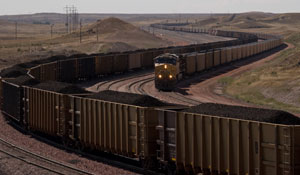Last month, the Department of Interior’s (DOI) Bureau of Land Management (BLM) auctioned 21 million tons of coal in Colorado, making us wonder if they understand the concept of climate change.
The antiquated federal coal leasing program – which started as a way to provide cheap electricity in the US and promote economic development – has basically become a freebie for coal companies.
They buy the coal at auction for ridiculously low prices – about $1 a ton – and because times have changed in the US and we use less coal, they ship it to Asia and sell it for 100 times that amount, says Greenpeace and WildEarth Guardians.
A report released this month from DOI’s Inspector General confirms that taxpayers are being ripped off and essentially subsidizing coal companies. It faults BLM for not considering potential profits from exporting coal.
Further, these "auctions" are a sham since 80% of them involve only one coal company! At this point all the auctions do is rip off taxpayers, feed climate change and postpone the transition to clean energy around the world.
This sale will expand Blue Mountain Energy’s Deserado mine in northwestern Colorado, the sole fuel source for the 500 megawatt Bonanza power plant in nearby Utah, which spews the same amount of carbon into the air as a million cars each year.
The aging coal plant was intended to shut down in 2016 but this coal sale will keep it going until 2032.
Next week, BLM will auction 721 million tons of coal from Wyoming’s Powder River Basin. Peabody Coal will be the sole "bidder."
That coal will release a gigaton of CO2, more than 10 times the amount the federal government hopes to cut of its own emissions over 10 years under President Obama’s Executive Order, says Joe Smyth of Greenpeace. And the government doesn’t even count them when it tallies US emissions.
About 40% of the coal mined in the US comes from our federal lands.
"Given that the cumulative total of coal exports from Oregon and Washington could result in CO2 emissions on the order of 240 million tons per year, it is hard to conceive that the federal government would ignore the inevitable consequences of coal leasing and coal export," say Govs. John Kitzhaber of Oregon and Jay Inslee of Washinton in a letter to the White House Council on Environmental Quality Chair, Nancy Sutley.
The US needs a "full public airing of the consequences" of "substantial new investments in coal generation and the infrastructure to transport coal, extending the world’s reliance on this fuel for decades."
In April, the third of six planned coal terminals for Oregon and Washington – from where coal would be exported to China – was shelved after its last financier pulled out. Kinder Morgan sited volatile energy demand and virulent environmental opposition as the reasons.
The Coos Bay project would have shipped about 11 million tons a year to Asia, according to Oregon Live. Coal companies want to export as much as 150 million tons a year, they say.
And just getting the coal from the Rocky Mountain states to the export terminals requires trains that can be a mile long, spewing coal dust all the way in violation of the Clean Air Act.
"The closest way from Montana to Asia is through our backyards and through our ports here in the Northwest," says Beth Doglio of the Power Past Coal Campaign. "If all the proposals on the table right now get built, the impacts to climate change and greenhouse gas emissions would actually be significantly more than those of the Keystone Pipeline."

Every day, more than 50 mile-and-a-half-long trains, laden with Powder River coal, would travel from Wyoming and Montana through hundreds of small towns to ports in the Pacific Northwest, leaving arsenic and mercury laden coal dust in their wake.
A proposed coal terminal in Australia has also been put on hold because of weak demand. That’s because China is beginning to address its devastating air pollution and cutting back on coal as fast as it can. In fact, power production from wind increased more than from coal for the first time in China in 2012.
"2013 will represent a watershed event for the seaborne market" because China’s thermal coal imports will fall this year, the first time that has occurred since the financial crisis in 2007-2008," says Goldman Sachs.
Indeed, the coal game may be changing. BHP Bilton, the world’s largest mining company, announced it will close some mines and sell others and has basically ruled out any new ones. They cite poor markets as the reason.
Still, coal supplied about 30% of the world’s energy last year, the highest level since 1969. And US utilities have been using more of it recently as natural gas prices have moved higher after dropping to 1988 levels.
Read more about this:
